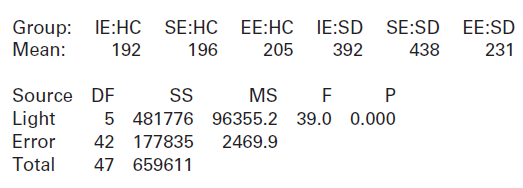Exercise 6.257 on page 424 introduces a study showing that exercise appears to offer some resiliency against
Question:

(a) Is there a difference between the groups in the amount of time spent in darkness? Between which two groups are we most likely to find a difference in mean time spent in darkness? Between which two groups are we least likely to find a difference?
(b) By looking at the six means, where do you think the differences are likely to lie?
(c) Test to see if there is a difference in mean time spent in darkness between the IE:HC group and the EE:SD group (that is, impoverished but not stressed vs enriched but stressed)
Exercise 6.257
Many studies have shown that people who engage in any exercise have improved mental health over those that never exercise. In particular, even a small amount of exercise seems to confer some resilience to stress. Most of these studies, by necessity, have been observational studies. A recent experiment with mice moves us one step closer to determining a causal association. In the study, mice were randomly assigned to either an enriched environment (EE) where there was an exercise wheel available or a standard environment (SE) with no exercise options. After three weeks in the specified environment, for five minutes a day for two weeks, the mice were each exposed to a €˜€˜mouse bully€€”a mouse that was very strong, aggressive, and territorial. At the end of the two weeks, the mice in the SE group exhibited maladaptive, depressive-like, and anxietylike behavior across a wide spectrum of activities. This was not true of the mice in the EE group; they behaved similarly to mice that had never had the stress-inducing bully experience. In particular, one measure of mouse anxiety is amount of time hiding in a dark compartment, with mice that are more anxious spending more time in darkness. The amount of time spent in darkness during one trial is recorded for all the mice and is shown in Table 6.22 and available in StressedMice. Test to see if mice that have spent time in an enriched environment with options for exercise spend significantly less time in darkness after a stress-inducing experience.
Table 6.22

Step by Step Answer:

Statistics Unlocking The Power Of Data
ISBN: 9780470601877
1st Edition
Authors: Robin H. Lock, Patti Frazer Lock, Kari Lock Morgan, Eric F. Lock, Dennis F. Lock





